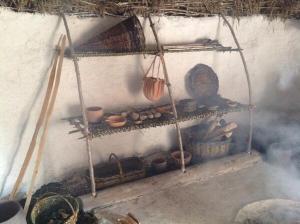
It is very exciting when archaeological evidence allows us to reconstruct or imagine small intimate details of the lives of people who lived thousands of years ago. The hard chalk floors of the Neolithic Houses excavated at Durrington Walls shed light on some of the domestic activities of the people who lived there – the people who may have built or used Stonehenge.
In one of the houses, just by the central hearth, two indentations were found and it has been suggested that these could be knee prints – from somebody spending long hours, day after day kneeling by the fireplace, tending the fire and cooking.
It is unlikely we will ever be able to prove or disprove this theory but reconstructing these houses has allowed us to see how the building materials work and how they settle. When the houses open in June, we will begin to observe the impact that general use and traffic will have on the chalk floors. The fires will be lit, the floors will be swept, people will be walking through, and generally interacting with the houses on a daily basis.
What do you think? Are these knee prints or just naturally occurring indentations in the hard chalk floor?
Thanks very much to Kate Welham of Bournemouth University and the Riverside Project for letting us use these two images of the floor of House 851 – which show the ‘knee-shaped’ indentations to the left of the circular hearth. Also visible are the beam-slot indentations where wooden furniture once stood around the edge of the floor.
photo by volunteer house builder Nick Jones




